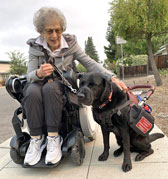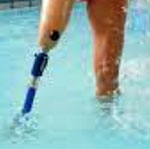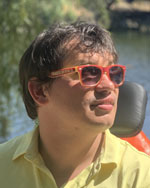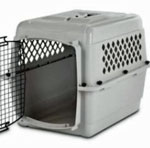|
Candidate
Team Projects - 2024
General Team Project
Information
- Team Projects are for suitable for
three students taking the course for three credit units.
- These projects will be "pitched" in
class on Thursday, January 11th
- Project suggestor email addresses
will be communicated to the student project team who chooses the
project.
- "Recommended Skillset" is dependent
on the selected design concept.
Index of Project Titles
(year originally suggested)

Back to top
 Projects with Abby Projects with Abby
-
2023 Biosketch: Abby
is an artist, a retired art teacher (grades K-College), a clinical social
worker, and a computer graphic designer. She is an individual with multiple
disabilities: a mobility challenge, a bipolar disorder, and a visual
impairment. She is passionate about making a difference and advocating for
individual rights. She has been a chair of the
Consumer
Advisory Council and formerly represented consumers on the Board of
Directors of the National Alliance on
Mental Illness (NAMI) in Santa Clara County and has volunteered in their
Connection
Recovery Support Group and the
Peer
PAL Program. She has also volunteered for the
Vista Center for the Blind and Visually
Impaired, has been on the
Board of Directors
of the Silicon Valley Independent Living
Center (SVILC), has successfully been involved in litigation to preserve
the rights of service dog recipients when they are hospitalized, and has
presented Poster Sessions and spoken at conferences including NAMI’s
National Convention, California ADA (Americans with Disabilities Act) 2015
Conference celebrating 25 years, the California Council of the Blind’s
Annual Convention, Cal Poly Tech Women
in Business, Defining Her Future
2021 panel on Diversity, Equity, and Inclusion. Abby has mentored
elementary school students with art lessons and partnered with high school
students in programs for Project Invent
and Design the Future and has
consulted with 7th and 8th grade students on designing for accessibility and
accessible obstacle courses. She has been interviewed for a
podcast
by Project Invent. Abby invented a board game for inpatient psychiatric
units. She has a successor service dog, Nathan, from
Canine Partners for Life (CPL) in
Cochranville, PA, and has presented
Service Dog
Demonstrations at Abilities Expo in 2018 and 2019. Abby has supported
products that increase functionality for individuals with disabilities ("How I
overcame vision loss with eSight" - video 4:30). She has recently completed
a graduate program at California State
University Northridge (CSUN) studying
Assistive Technology
Studies and Human Services. Abby presented at CSUN’s 38th Assistive
Technology Conference on “How to Teach Compassion with Assistive
Technology" and will be presenting at CSUN's 39th Assistive Technology
Conference on "The Importance of the User in the AT Design Equation". Abby has
joined the faculty of the Assistive Technology Engineering graduate program at
CSUN.
| Back to top
 Treats for
Nathan Treats for
Nathan
-
Background: Abby
is an older adult who relies on a powered wheelchair for her mobility and her
service dog, Nathan, to help her with daily tasks.
-
Problem: Abby
routinely rewards Nathan for continuous training and for his service with small
food treats. However, finding, retrieving, and opening the treat bag and
selecting one treat item can be a struggle for her as the bag may be stored
inside a backpack behind her wheelchair seat and fine hand dexterity is
required to open the treat bag and pull out a small treat.
-
Aim: Explore
solutions that would enable Abby to easily reward Nathan.
-
Design
Criteria:
- Must accommodate
multiple treats
- Must must open
quickly, widely, and easily to access treats
- Must close tightly
to avoid spoilage and spillage and release of treat scent
-
Suggestion:
Consider various dispensing and mounting options
-
Links:
-
Recommended
Skillset: Mechanical Engineering
|
| Back to top
 Enhanced Visibility Project
for Abby's Wheelchair Enhanced Visibility Project
for Abby's Wheelchair
-
Background: "The
WHILL does have some rear lights, but no real way to illuminate my path for
early morning or late afternoon activities such as walking my dog or going out
at night. This is a real problem when you consider where there are van
accessible parking spaces and locations of activities. A movie and restaurant
outing with may include parking one place, and meeting friends in a location a
block or so away. Lighting is not always available in parking lots, and many
time parking lots are located in back of buildings. Adequate lighting means the
difference between safe maneuvering both me and my dog wherever I want to
go."
-
Problem: Abby's
wheelchair has limited front & side ighting which creates a safety hazard
while walking Nathan in the early morning or traveling at night.
-
Aim: Explore
ways to enhance the night time visibility of Abby's wheelchair.
-
Design
Criteria:
-
Other:
-
Links:
-
Recommended
Skillset: Mechanical Engineering
|
| Back to top
 Rain Shield
Project Rain Shield
Project
-
Background: Abby
is an older adult who relies on a powered wheelchair for her mobility and her
service dog, Nathan, to help her with daily tasks.
-
Problem:
Wheelchair users and their mobility devices must be protected from the rain as
being wet is uncomfortable and water can damage electronics.
-
Aim: Explore
designs for a suitable covering (a garment or wheelchair / scooter accessory)
to protect Abby and her mobility device.
-
Design
Criteria:
- Suitable for use
with Abby's scooter and Whill
- Aesthetic
design
- Collapsible and
stowable
- Easy to put on and
remove and/or easy to deploy and retract
-
Search Link:
"rain protection for wheelchair user"
-
Recommended
Skillset: Mechanical Engineering, Shop
|
| Back to top
 Accessible Storage
Solution Accessible Storage
Solution
-
Problem:
Wheelchair users, like Abby require storage space for many large and small
accessories such as a coat, laptop, keys, cellphone, water bottle, and items
for service dogs including treats, food, blanket, leash, etc. Current storage
solutions are attached behind the wheelchair, which makes retrieving items
challenging.
-
Aim: Explore
designs for an accessible storage solution.
-
Design
Criteria:
- Easy to attach and
remove storage solution from Whill wheelchair
- Easy to pack and
retrieve items
- Includes
compartments for large and small items
- Includes compartment
for food items that must be kept cold
- Provides security
from theft
-
Other:
-
Links:
-
Recommended
Skillset: Mechanical Engineering, Shop
|
| Back to top
 Universal Water Bottle and
Phone Holder Universal Water Bottle and
Phone Holder
-
Background: Abby
uses four different mobility devices on different occassions: 2 Whill
wheelchairs, a motorized TravelScoot scooter, and a manual
wheelchair.
-
Problem: Abby
could benefit from a conveniently located water bottle and phone holder on her
mobility devices. Currently she has to dig through storage bags that she
carries on the side or the back.
-
Aim: Explore
designs for a water bottle and phone holder that she can easily
access.
-
Design
Criteria:
- The solution must
not interfere with the operation of her mobility devices
- The solutionr must
be able to be easily moved and installed on any of her devices
-
Link:
-
Recommended
Skillset: Mechanical Engineering, Shop
|
|

Back to top
 Projects with Olenka at the Magical Bridge Playground Projects with Olenka at the Magical Bridge Playground
Accessible and Inclusive Playground Attractions
-
-
Background: The
Magical Bridge Playground is
recognized as the nation's most innovative accessible and socially inclusive
playground. It is designed to delight the many people who make up our
community, including the 1 in 4 living with a visible or invisible disability
who are typically overlooked in the creation of public playgrounds. It is a
multigenerational play space with areas for respite, along with thoughtful
programs which include
Kindness
Ambassadors. The original playground was spearheaded by Palo Alto citizen
volunteer and former tech executive, Olenka (Villarreal). Along with dozens of
volunteers and 0.8 acres of underutilized public land in Mitchell Park, she was
determined to create the most magical playground to bridge the gap between
those with and without disabilities in such a seamless way that everyone would
love it. Located at
600
East Meadow Drive in Palo Alto, the volunteers raised $4.2M in private
funds to showcase how a truly inclusive playground creates a welcoming spirit
for a community. Magical Bridge Playground is adjacent to
AbilityPath and close to
Ada's Cafe and the
Mitchell Park
Library.
-
The
playground
opened in April 2015 and enjoys an average of 25,000 visitors a month. Many
are local families, while others come from long distances.
-
After this playground
was completed, Magical Bridge
Foundation was formed in 2016 with a mission to advocate for more inclusive
play spaces and programs that consider the needs of all ages and all abilities.
The foundation now has 12 new destination playgrounds under construction, and
is also developing an exciting plan for elementary school playgrounds to put
more magic into recess! Besides Palo Alto, Redwood City, Addison Elementary
School and CuriOdyssey Museum and Zoo are
now proud to have a Magical Bridge of their own. International sites are also
underway.
-
Problem: The
park's play equipment has been well-received, but some aspects of the play
areas could be modified for better access. In addition, suggestions for
replacement play areas are sought to update the park with innovative
installations every few years. And as new Playgrounds are planned and
constructed, there are ongoing opportunities to design new features and refine
existing designs to be accessible to everyone regardless of their
abilities.
-
Aim: Explore
designs to create new play and educational experiences incorporating multiple
senses, actions, and outcomes for all playground users and visitors, especially
those with visual impairments and diminished fine motor skills.
-
Design
Criteria:
- Designs should be
durable, fun, and safe for everyone - accommodating children and parents with
disabilities - and be magical for all ages and all abilities.
- Project prototypes
could be scale models to facilitate their construction and
transportation.
- Designs that
incorporate electronics should be low-voltage or solar-powered.
- Consider designs for
kids and older adults.
-
Suggestion: Employ
actuators (levers, pulleys, buttons, etc) to activate sound, music, motion,
lights.
-
Recommended
Skillset: Mechanical Engineering, Mechatronics, depends on selected design
concept
-
Links:
-
|

Back to top
 Project with Gary Project with Gary
Swimming with a Prosthetic Device
-
-
Background: Lower
limb prostheses (artificial limbs) are often made of a variety of materials.
These materials must be strong enough for daily high level activities and must
last for 3 to 5 years. Steel, aluminum, and titanium are the primary component
materials due to their strength and weight. However the bolts that hold these
together are often steel due to their strength and fatigue properties. Further,
water and dirt ingress are often a problem when using these components in the
water or wet / dirty / sandy environments. This is a particular issue with
children and is exacerbated by salt water.
-
Problem: People
who live near the ocean like to walk on the beach and go in the water but their
prosthesis is often damaged over time due to water, salt, sand, and
dirt.
-
Aim: Explore
solutions that would permit an individual to swim and go on the beach without
damaging his / her prosthetic device.
-
Design
Criteria:
- Consider materials,
either removable or permanent, or processes that would protect the device from
damage from water, salt, sand, and dirt.
- The solution must not
affect the device's function or comfort.
-
Suggestions:
Consider coatings or coverings or partial component material changes as well as
techniques or processes that protect the device from the effects of water,
salt, sand, and dirt.
-
Recommended
Skillset: Mechanical Engineering, Shop, depends on selected design
concept
-
Link:
|

Back to top
 Kinematic / Kinesthetic Project Kinematic / Kinesthetic Project
Dancing with Assistive Technology
-
Background: Kinematic
/ Kinesthetic is a dance performance project centered around disability
robotics that will premiere at the San Francisco Exploratorium in 2025. The
project uses technological innovation as a tool for artistic generation by
developing robotic technologies to research new movement possibilities for
disabled and non-disabled dancers. Kinematic / Kinesthetic is supported by a
Hewlett
50 Arts Commission grant, led by Ben Levine of
Extreme Lengths Productions in
collaboration with AXIS Dance
Company.
-
Problem: Many
assistive movement technologies are created on the medical model, aiming to
“fix” physical disabilities and replicate non-disabled-bodied
movement, focusing on everyday function. Kinematic / Kinesthetic is not
interested in the goals of such existing technologies. The project aims to
explore unfamiliar, species atypical, and/or “superhuman” movement
beyond that of replication and assimilation to expand understandings of ability
and embodiment.
-
Aim: Kinematic /
Kinesthetic artists need technology to create with! The project needs
prototypes of potential assistive movement technology / robotics to be worn by
dancers with and without disabilities that focus on the expressive capabilities
of movement, as opposed to a focus on everyday function.
-
Recommended Skillset:
Mechanical Engineering, Mechatronics, depends on selected design
concept
-
Link:
|

Back to top
 Projects with Danny Projects with Danny
-
Background: Danny is a
wheelchair user from Los Gatos with cerebral palsy. He experiences limited
upper body strength, grip & vision impairments, and diminished hand &
finger dexterity.

Back to top
 Dog Kennel Project for Danny's Service Dog
Korey Dog Kennel Project for Danny's Service Dog
Korey
- Problem: It is
challenging for Danny to care for many of the needs of his service dog, Korey.
His limited upper body range of motion, weak grip strength, and impaired vision
make it difficult to operate the latch and open the door of the kennel (dog
crate) where Korey sleeps.
-
Aim: Explore
designs that would enable Danny to independently care for Korey by providing an
easier way to open & close and latch & unlatch Korey's kennel
door.
-
Design
Criteria:
- Provides a solution
that does not require Danny to bend over
- Requires low force
to operate
- Escape-proof
-
Suggestion: The
design can be an adaption of a commercial product.
-
Recommended
Skillset: Mechanical Engineering, Shop, Electronics
-
Links:
|
|
Back to top
 Poop Management for Danny's Service Dog Korey Poop Management for Danny's Service Dog Korey
-
Problem:
Wheelchair users who walk their dogs need to clean up after them. Danny's
limited hand / arm strength and reduced mobility affects his ability to
successfully perform both the collection and bagging portions of this
task.
-
Aim: Explore
designs for a poop management system for Danny's service dog
Korey.
-
Design
Criteria:
- Consider sanitation
and odor issues
- Easy for Danny to
use
- Simple in design,
low-cost, lightweight, able to store on his wheelchair
-
Recommended
Skillset: Mechanical Engineering, Shop
-
Links:
- Search for "poop
management for service dogs"
|
|
Back to top
 Laptray for Danny Laptray for Danny
-
Problem: Danny's
wheelchair does not have a laptray or a place to store items such as his cell
phone, clothing, wallet, and plates of food. Items placed on his lap usually
fall off when he propels his wheelchair.
-
Aim: Explore
ways for Danny to easily access and store his personal items on his wheelchair
and retrieve them when they fall to the floor.
-
Design
Criteria:
- Danny must be able
to independently deploy and stow the laptray
-
Recommended
Skillset: Mechanical Engineering, Shop
-
Links:
|
|
Back to top
 Treats for Korey Treats for Korey
- Background:
Danny benefits from the help of his service dog, Korey.
-
Problem: Danny
would like to routinely reward Korey for his service with small food treats.
However, finding, retrieving, and opening a treat bag and selecting one treat
item can be a struggle for him as the bag may be stored inside a backpack
behind his wheelchair seat and fine hand dexterity is required to open the
treat bag and pull out a small treat.
-
Aim: Explore
solutions that would enable Danny to independently reward Korey.
-
Design
Criteria:
- Consider alternative
treat delivery mechanisms.
-
Recommended
Skillset: Mechanical Engineering, Shop
-
Links:
|
|
|
 Projects Suggested by Dave: Projects Suggested by Dave:
|
Back to top
 Designing Your
Afterlife Designing Your
Afterlife
-
Background:
Death is the most severe form of disability as one is no longer able to
interact with people or physical objects in the living world. What remains are
only frozen static artifacts - images, writings, and the stories of others.
Gone are one's personality, beliefs, expertise, humor, vision, memories,
insights, and intellect.
-
Problem: With
one's passing, it is impossible to provide a full and accurate representation
of whom they were, what they believed in, and how they acted. The recollections
of family and friends fade and disappear with time, leaving the departed one's
legacy at the mercy of the living.
-
Aim: Explore
ways to preserve one's essence after death. In the technology extreme, this
might manifest itself as an interactive system that responds to queries,
retells stories, relates experiences, shares expertise, and expresses humor.
The pre-dead user would be able to create and program his / her eternal
computer-based persona before her / his demise.
-
Other:
-
Recommended
Skillset: Various, depends on chosen solution
-
Links:
|
|
Back to top
 Creative
Expression Creative
Expression
-
Background: Most
everyone has a desire to be creative through activities such as writing,
painting, sculpture, pottery, jewelry, quilting, photography, singing, dancing,
and music.
-
Problem:
Existing tools supporting creativity are often lacking for people with
disabilities. Movement difficulties may prevent an individual from fully
participating in their chosen activity.
-
Aim: Explore
ways to enhance creative expression for people with disabilities. This could
include the creation of new activities or fabrication of new
tools.
-
Suggestions:
- Convert the user's
existing assistive technology device into a creative "paintbrush" or "musical
instrument"
- Use non-traditional
inputs such as residual movements or brain waves
- Adapt or create
instruments for musicians with disabilities
- One-Handed Musical
Instrument (OHMI) Competition
-
Other:
-
Recommended
Skillset: Various, depends on chosen solution
-
Links:
|
|
Back to top
 Student-defined
Projects Student-defined
Projects
-
- Meet with the course
instructor to discuss and agree upon the specifics of the project. Interview,
observe, and discuss assistive technology problems with an individual with a
disability or older adult. Address their desire to participate in one of the
following activities by designing an adaptation to an existing device / tool or
creating a new, more useful one. Projects could address:
-
-
Activities
of Daily Living - cooking, showering or bathing, dressing, cleaning,
housework, yard work, employment, education, shopping, commuting,
etc
-
Sports and
Exercise - walking, running, indoor and outdoor sports, etc
-
Leisure
Activities and Hobbies - collecting, model making, crafts, board games
& videogames, etc
|
|
|
Back to top
 Title Title
-
Background:
-
Problem:
-
Aim:
-
Design Criteria:
-
Links:
|
Back to
top
|